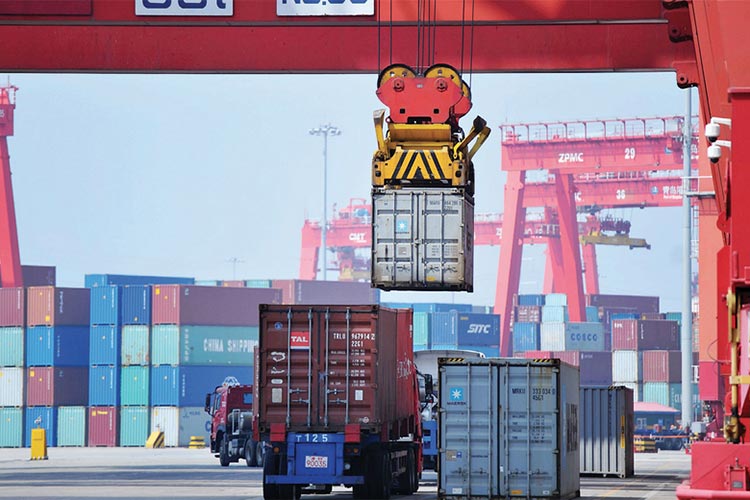China’s February exports tumble to create ripples in economy

A container is transferred at a port in Qingdao, China. Agence France-Presse
While seasonal factors may have been at play, the shockingly weak readings from the world’s largest trading nation added to worries about a global slowdown, a day after the European Central Bank slashed growth forecasts for the region.
Asian stock markets and US futures extended losses after the data. Chinese stocks sank over 4 per cent in their worst day in five months.
Global investors and China’s major trading partners are closely watching Beijing’s policy reactions as economic growth cools from last year’s 28-year low. But the government has vowed it will not resort to massive stimulus like in the past, which helped revive demand worldwide.
February exports fell 20.7 per cent from a year earlier, the largest decline since February 2016, customs data showed. Economists polled by Reuters had expected a 4.8 per cent drop after January’s unexpected 9.1 per cent jump.
“Today’s trade figures reinforce our view that China’s trade recession has started to emerge,” Raymond Yeung, Greater China chief economist at ANZ, wrote in a note.
Imports fell 5.2 per cent from a year earlier, worse than analysts’ forecasts for a 1.4 per cent fall and widening from January’s 1.5 per cent drop. Imports of major commodities fell across the board.
That left the country with a trade surplus of $4.12 billion for the month, much smaller than forecasts of $26.38 billion.
Analysts warn that data from China in the first two months of the year should be read with caution due to business disruptions caused by the long Lunar New Year holidays, which came in mid-February in 2018 but started on Feb.4 this year.
But many China watchers had expected a weak start to the year as factory surveys showed dwindling domestic and export orders and the Sino-US trade war dragged on.
“Seasonal distortions around the Chinese New Year holiday has added noise to the export data in the past two months, and in our view explain most of the surprise (relative to consensus),” said analysts at Goldman Sachs, whose estimate for a 20 per cent export drop was the most pessimistic in the Reuters poll.
But they noted that export momentum on a three-month basis has moderated significantly since the third quarter last year and said “growth is likely to remain soft in the near future.”
The increasingly weak China data comes amid months of intense negotiations between Washington and Beijing aimed at ending their trade dispute.
On Wednesday, the US reported its goods trade deficit with China surged to an all-time high last year, underlining one of the key sticking points.
China’s data on Friday showed its surplus with the United States narrowed to $14.72 billion in February from $27.3 billion in January, and it has promised to buy more US goods such as agricultural products as part of the trade discussions.
US President Donald Trump said that trade talks were moving along well and predicted either a “good deal” or no deal between the world’s two largest economies.
Trump postponed a sharp US tariff hike slated for early March as the talks progressed, but both Washington and Beijing have kept previous duties in place.
The Chinese government’s top diplomat, State Councillor Wang Yi, said on Friday that talks had made substantive progress, and that the two countries’ relations should not descend into confrontation.
But the New York Times reported that Chinese officials are leery of continued discussions and don’t want to commit China to structural changes in its economy.
China’s economy was already slowing last year before trade tensions escalated, due in part to a regulatory clampdown on riskier lending that starved smaller, private companies of financing and stifled investment.
Even if a trade deal is reached, its exporters will have to contend with weakening demand globally, particularly in Europe. China’s exports to all of its major markets fell across the board last month.
The government is targeting economic growth of 6.0 to 6.5 per cent in 2019, Premier Li Keqiang said at Tuesday’s opening of the annual meeting of parliament, a lower target than set for 2018.
Actual growth last year slowed to 6.6 per cent, and is expected to cool further to 6.2 per cent this year. Many analysts expect a rocky first half before a flurry of stimulus measures start to stabilise activity around mid-year.
China’s slowdown and the trade war are having an increasing impact on other trade-reliant countries and businesses worldwide.Imports from Japan sank 19.3 per cent in February compared with a month earlier, Chinese customs data showed.
Reuters



